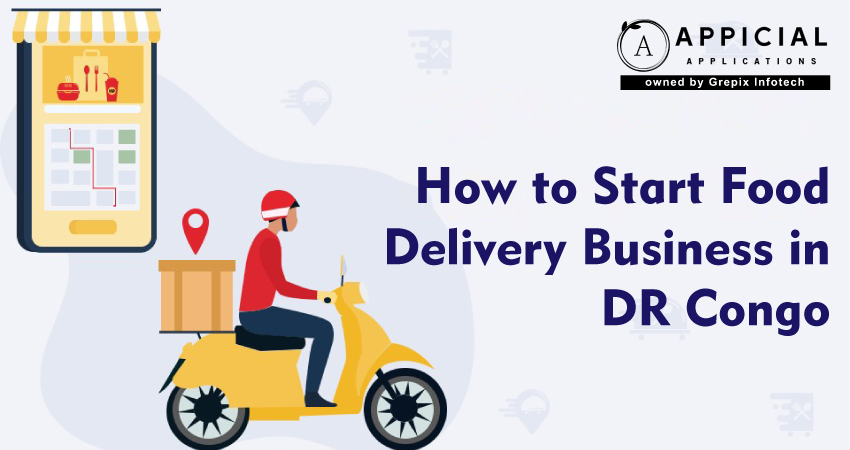
How to Start a Food Delivery Business in DR Congo
Daily life in DR Congo is changing fast.
More people use smartphones. More people go online via mobile data. In Kinshasa, Lubumbashi, Goma, and other cities, residents expect convenience. They want to order food from home. They expect live updates. They expect reliability.Right now, most people rely on phone calls, WhatsApp, or SMS to order food. They might wait hours. Deliveries can fail. Tracking doesn’t exist. That’s inefficient.
This is where a Food Delivery App can transform things. A mobile app with menus, live tracking, and mobile payment can bring real value.
There’s a gap. Few platforms exist. Big players like Uber Eats or Grubhub aren’t present in DR Congo. That means opportunity.
If you're thinking about building an Online Food Delivery App, now is the time. In this blog, we’ll guide you, step by step from why to invest to launch strategy, features, challenges, costs, and how Appicial Applications can support you.
DR Congo is witnessing slow but steady growth in internet and mobile penetration. By early 2024, around 28 million people, or roughly 27% of the population, used mobile internet, and over 50% owned mobile phones. Despite widespread smartphone usage, food delivery services remain scarce in most cities. Most ordering is done via WhatsApp or phone calls. That creates a gap. A quality Food Delivery App can meet rising expectations. This blog breaks down why now is the time to build an Online Food Delivery App, what features it needs, what tech to use, key market obstacles, and how Appicial Applications, a top Food App Development Company, can help you create a Food Delivery App from concept to launch.
Why Invest in Food Delivery App Development in DR Congo?
Here’s why starting a Food App Development Company or building a Food Delivery Clone App platform in DR Congo makes sense:
1 Rising Internet Access
Internet penetration in DR Congo stood at roughly 27% in early 2024, up from under 18% in 2022, and now reaches around 28 million users. The rate is still low, but growing particularly fast in cities.
2 Mobile Coverage and Smartphone Growth
Over 50% of the population holds mobile subscriptions, and most access the internet via mobile data networks. About 90% of internet users rely on mobile phones. Smartphones, often low-cost Android devices, are common in urban areas.
3 Electronification and Mobile Money
Cash remains dominant, but digital payments are growing. Telecoms and microfinance providers offer mobile wallets like Vodacom M-Pesa, Orange Money, Airtel Money, and Afrimoney. A Create Food Delivery App must integrate these payment methods.
4 Untapped Market, Low Competition
Global brands like Uber Eats or Grubhub Delivery are not present. Local food delivery is mostly informal. That means no dominant Food Delivery Platforms yet. The first quality player can win early.
5 Urban Lifestyle and Demand
DR Congo urbanites, especially young people, value convenience. They want to order food from apps. They expect menu variety, fast delivery, and digital payments.
6 Supportive Regulations
In 2023, DR Congo passed a new digital code—formalizing e-commerce, electronic signature rules, and digital services regulation. That legal clarity supports startups in tech sectors.
7 Repeat Revenue Potential
Food delivery builds recurring usage. Customers order meals daily or weekly. Restaurants partner for visibility. And the platform gains traction fast once trust is built.
All this adds up: demand is growing, digital habits are shifting, and few reliable platforms exist. The time to build a food Delivery App in DR Congo is now.
What are Must-Have Features for a Food Delivery App?
Your Food Delivery App must deliver a great user experience and operational efficiency. Here are key features:
Customer App
- Quick sign-up via phone, email, or social login
- Browse restaurant menus with photos and prices
- Search and filter by cuisine, ratings, or delivery time
- Place orders and track them live like Uber Eats Delivery or Grubhub Delivery
- Receive order updates via push and SMS
- Pay with mobile wallet, credit/debit card, or cash on delivery
- Rate orders and leave reviews
Restaurant Partner App
- Accept or decline new orders
- View orders in real time
- Send status updates: preparing, ready, picked up
- Simple dashboard showing revenue and order volume
Delivery Courier App
- View assigned deliveries
- Use route navigation and optimized paths
- Update statuses: picked up, delivered
- Track earnings and completed jobs
Admin Dashboard
- Manage restaurants, customers, and couriers
- Monitor orders and performance metrics
- Apply commissions and delivery fees
- Run promotions and management tools
- Support and chat interface for resolving tickets
Integrations & Extras
- Real-time mapping (Google Maps or Mapbox)
- Mobile notifications via Firebase or Twilio
- Payment SDKs for local wallets and cards
- Analytics for daily orders, cancellations, and top restaurants
This stack aligns with global apps Uber Eats Delivery, DoorDash Food Delivery App, and Grubhub Food Delivery App experiences, but is built for the local context.
Technology Stack and Architecture
Here’s a practical tech stack that helps scale and stay efficient:
Frontend
- Flutter or React Native for Android & iOS apps
- React.js or Angular for web-based admin panel
Backend
- Node.js (Express) or Python (Django/Flask)
- PostgreSQL or MongoDB for data storage
- Redis for caching and session handling
Third-party Tools
- Google Maps or Mapbox for routing and location
- Firebase or Twilio for push and SMS alerts
- Local mobile wallet APIs such as Vodacom, Orange Money integrations
Hosting & Scalability
- Cloud deployment on AWS, DigitalOcean, or GCP
- Modular microservices for customer, restaurant, courier, and admin logic
- CI/CD pipeline for smooth deployment and updates
Security and Data
- Secure authentication (JWT or OAuth)
- SSL encryption for data in motion
- GDPR-like data protection rules within DR Congo’s digital code
This architecture supports real-time updates, multiple user roles, scalable growth, and integration of payment services and mapping services.
What are the Challenges and Market Gaps in DR Congo?
DR Congo presents specific obstacles. Overcoming them will differentiate your platform.
1 Poor Broadband and Intermittent Connectivity
Most internet use is via mobile data. Speeds vary, and coverage remains poor outside major cities. Your app must be lightweight and offline-tolerant.
2 Low Banking Penetration
Most users don’t have bank accounts. Mobile wallets are more common. Cash-on-delivery is still popular. Build for mobile money, cash orders, or hybrid payments.
3 Inconsistent Road Conditions
Traffic and poor infrastructure slow deliveries. Expect delays. Provide realistic ETA updates and fair delivery zones.
4 Food Safety and Reliability
Users worry about hygiene and delivery quality. Display restaurant compliance, offer insurance or refunds, and collect feedback to maintain trust.
5 Restaurant Buy-In
Many restaurants are small, informal businesses. They may lack digital literacy. Onboarding and training are essential so that they use the platform correctly.
6 Trust in Digital Platforms
People may hesitate to enter their card or wallet details. Visible tracking, secure payment, and consistent service build trust over time.
If you design features with these realities in mind, your app will feel local, trusted, and reliable from day one.
What is the Estimated Development Cost & Timeline?
Here’s a breakdown of time and cost to create a Food Delivery App in DR Congo.
Phase 1: MVP Development
- Android & iOS customer app, restaurant and courier apps, basic admin panel
- Order tracking, listing menus, payment integration, notifications
- Testing in the Kinshasa pilot area
- Timeline: 3–4 weeks
- Estimated cost: US$25,000–40,000
Also Read: How to Start a Food Delivery Business in Ethiopia
Phase 2: Full Platform Enhancements
- Ratings, promotions, advanced analytics, multi-language, expanded payment methods
- Courier incentives and referrals, admin marketing tools
- Timeline: Additional 3–4 weeks
- Estimated cost: US$40,000–70,000+
Ongoing Costs
- Hosting, maintenance, support
- Restaurant onboarding & marketing
- Feature updates and local compliance updates
Start with a lean MVP. Validate with real users. Then add features as you grow into a full platform.
How Appicial Applications Can Help?
Appicial Applications is an experienced Food Delivery App Development Company with success in emerging markets. Here’s how we help you launch and scale:
Pre-built Templates
We offer scalable templates inspired by Uber Eats, DoorDash, and Grubhub Delivery Services. Easily customizable to the DR Congo context.
Local Payment Integrations
We support integration with Vodacom M-Pesa, Orange Money, Airtel Money, Afrimoney, and bank card options where applicable.
Optimized for Low-End Android Phones
Our apps are lightweight, fast one-click load, and use minimal data, critical for users on limited mobile connections.
Restaurant & Courier Onboarding
We provide multi-language interfaces (French, Lingala, Swahili), training guides, and support to help local partners adopt the system quickly.
Post-Launch Support
From customer service tools to performance analytics, we help you grow your platform, manage growth, and optimize operations.
Transparent Pricing for Startups
We work with startup budgets and phased deployment plans. No hidden costs, complete ownership, scalable for growth.
With Appicial, you get tools, tech, and strategy, powered by local insight and global standards.
Conclusion
The DR Congo market is primed for disruption in food delivery apps.
Connectivity is rising. Smartphone adoption is growing. Young urban consumers want digital convenience and fast service. Yet the market is crowded with informal solutions and lacks reliable, scalable Food Delivery Platforms.
By building a trusted Food Delivery App with safe payments, live tracking, simple UI, and local support, you can lead the market.
Start with a minimal viable product. Test in cities like Kinshasa. Learn fast. Iterate. Then expand to other regions.
If you partner with a skilled Food App Development Company like Appicial Applications, you get local customization, scalable architecture, and expert support.
Let’s fill this gap. Build something that Angolan restaurants and consumers can rely on. Launch now, before someone else does.
FAQs
Author's Bio

Vinay Jain is the Founder at Grepix Infotech and brings over 12 years of entrepreneurial experience. His focus revolves around software & business development and customer satisfaction.
Back to blog list




